She Again Went Comma After Again
Lesson xiii: Commas
/en/grammar/abbreviations-and-acronyms/content/
What is a comma?
A comma is a punctuation marking that can exist used in many different ways. Mainly, information technology's used to divide things—for instance, 2 thoughts in a sentence, multiple adjectives, or items in a list.

There are many rules that tell us how commas should be used, only don't let information technology scare you. With a little practice, it'll start to feel like 2d nature. Some rules are set in stone. They piece of work the same style every time, so y'all don't take to think about them also much. Other rules are more than complicated. In these cases, you have to understand the meaning of the sentence to know when and where to use the comma.
Using commas
The basic rules for using commas are pretty foolproof. In other words, they're like shooting fish in a barrel to utilize to your writing considering they always piece of work the same manner. You don't take to worry about any special exceptions or wonder where the comma is supposed to go. Each dominion tells yous exactly what to do.
Joining two sentences
You already know how to bring together ii sentences using conjunctions like and, or, just, and so. We do it all the time in regular chat, if non in writing.
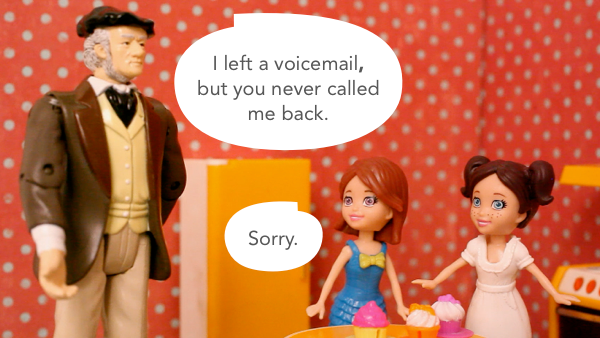
As you can run across, the comma goes between the 2 sentences, right earlier the conjunction. It tells you where one thought ends and another begins. Placing the comma after the conjunction would be incorrect because the conjunction is part of the second thought.

Listing items in a sentence
Commas can also exist used to dissever three or more items in a list. Just place a comma between each item (and an appropriate punctuation marker at the end). The last detail is usually joined past a conjunction like and, or, or nor. Like the dominion for joining sentences, the comma goes right before the conjunction.
![]()
Identify names and dates
In that location are certain types of place names (for case, city/land and state/country) that are always separated by a comma when you write them out. Y'all can see this dominion in activity on any mailing envelope.

Phoenix is a identify inside Arizona—that'southward why there's a comma betwixt the city and state. This rule applies whenever yous refer to a place in a similar way, whether it's MTV Studios , Times Square (which isn't fifty-fifty a city, state, or state) or England , U.k..
Dates work well-nigh the same way. For instance, when you write the full date, it should look something similar this: January 1, 2014. It'southward most every bit if the day and the month are inside the year—which is truthful, in a way. We're talking about January 1 in the twelvemonth 2014. That's why there's a comma between the engagement and year.

Quotations
Quotations are usually made up of two things: a quote (what the person said) and a tag (the person who said it). Commas play an important function too—they separate the quote from the tag, so we can tell they're dissever but connected.
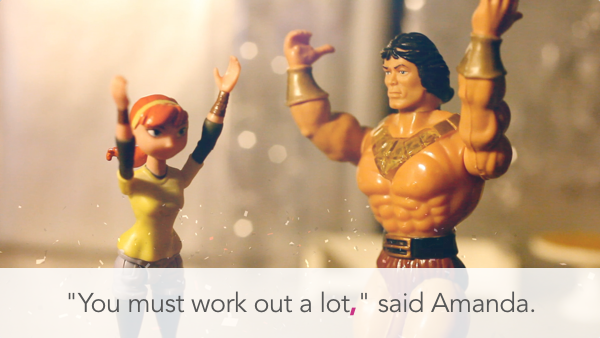
And then where does the comma become? It depends on the layout of the sentence. Here are three examples.
- Before the quote: Vanessa asked, "Is anyone else hungry?"
- After the quote (inside the quotation mark): "I could become for some pizza," said Elizabeth.
- Both ways (in the center of a quote): "I want pizza," said Rick, "but not with anchovies!"
To learn more, take a look at our lesson on Quotation Marks.
There are ii commas missing from the example below. Can you lot tell where they're supposed go? Click the dots to encounter if yous're correct!
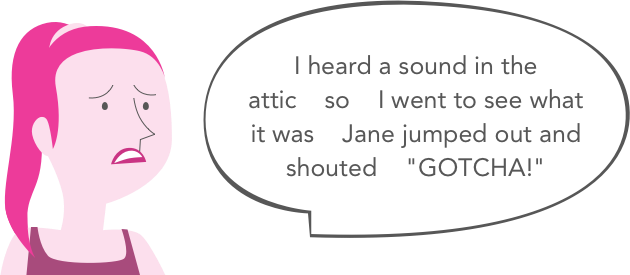
Nope!
That's not quite right, but you're close. Retrieve: when joining two sentences, the comma always goes before the conjunction.
That's right!
This is where the beginning comma should become—right earlier the conjunction . It tells you where one thought ends ( I heard a sound in the cranium ) and another 1 begins ( I went to meet what it was ).
Try once more!
This should be a menstruation , not a comma. You tin tell considering the next sentence is a consummate judgement (and at that place's no conjunction joining them together).
Right!
This is a good example of a quote that comes after a tag. In a case similar this, the comma always goes earlier the quote (outside the quotation marks).
More commas
To utilize commas in more complicated sentences, you lot'll accept to utilise your judgment. This means you'll need to think about each sentence (and make sure y'all actually understand what makes it work) before you lot tin apply the comma.
Don't let this scare you. As always, it'south non the end of the world if you make a mistake. If yous get stuck on a dominion, attempt looking closely at the instance—sometimes information technology helps to see the dominion in activeness. If you're non a native English speaker, these rules can be especially difficult to grasp. Yous may want to inquire someone you know for help, such every bit a friend, coworker, or teacher.
Adjectives
Another fourth dimension you utilise commas is when yous have two or more adjectives in a judgement. But identify the comma betwixt them—this separates them and makes the sentence easier to read.
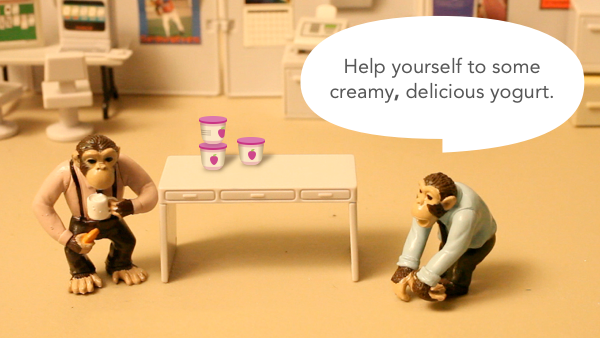
This rule is pretty universal, simply it isn't always true. You should only use a comma if the adjectives are interchangeable.
Interchangeable means you tin can list the adjectives in whatsoever club and information technology won't change the pregnant of the judgement. To discover out if two adjectives are interchangeable, endeavour reversing them—then see if the sentence withal makes sense.

Hither's the aforementioned instance with a different pair of adjectives: succulent and frozen. This time, the adjectives aren't interchangeable. (If you reverse them, you can probably see why.) This means they shouldn't exist separated with a comma.
![]()
The truth is, frozen yogurt is more than but an adjective followed by a noun. It's type of matter, like a miniature poodle, striped shirt, or even hot chocolate. All of these examples are made up of 2 words, only they represent a single affair. If you dissever them with a comma—or write them in a unlike order—the words lose their significant.
Introductory clauses
Y'all might already know that an incomplete judgement is a fragment. When y'all begin a sentence with a fragment, it'south called an introductory clause. (To learn more than, cheque out our lesson on Fragments.)
It'due south perfectly OK to begin a sentence this way, and so follow it with a consummate thought. You just have to separate these thoughts with a comma. This makes the sentence easier to read, and it also tells the reader where to pause if needed.

In the example above, the affair before the comma (while you were sleeping) is a fragment; the matter subsequently the comma (I gave you lot a new haircut) is a complete sentence. The comma is necessary only if the clause introduces the sentence. If the phrases were written in the opposite guild, you lot wouldn't use a comma.
What about expressions like luckily, however, and every bit you lot can see? Information technology's more common to run into these at the beginning of a sentence, but they can appear the end too. Different introductory clauses, they don't necessarily add anything new to the judgement. Regardless, they should always be separated by a comma. For example: I gave you a new haircut, every bit you lot tin can see.
Nonessential clauses
You should likewise use commas to separate nonessential clauses that appear in the middle of a sentence. A nonessential clause is something that adds meaning only that isn't completely necessary. In other words, if y'all took it out the sentence would nonetheless hateful basically the aforementioned thing.

To notice out if a clause is nonessential, effort removing it from the judgement, then run across how it sounds. The judgement higher up would all the same make sense if we removed the detail about the ascot. It would be: Steve is very tidy.
If the clause was essential, nosotros wouldn't be able to remove it. Try this judgement instead: Men who clothing ascots are very tidy. If we accept out the item about the ascot, nosotros're left something slightly different: Men are very tidy. This is far too general to exist truthful—afterward all, some men are really sloppy. This is how you lot know the clause is essential to the judgement's pregnant.
Other cases
As you gain more experience with commas, you'll run into cases when your judgment matters more than always. These cases are more difficult to ascertain, merely they build on the rules nosotros just discussed.
For instance, some sentences end with a blazon of fragment called a free modifier. This is but a fancy word for something that clarifies or relates to another part of the sentence. When you use a gratis modifier like this, e'er separate it with a comma.
![]()
Other sentences end with a singled-out pause, followed by something more than ambiguous. That final shell could exist the name of the person you're talking to, a statement of confirmation, or a single word. Whatever it is, that beat also should exist separated by a comma.

Below are two sentences that include a series of commas—ane is correct, and the other is not. Use what you just learned to determine which 1 is correct, then click the dots to see if you're right!
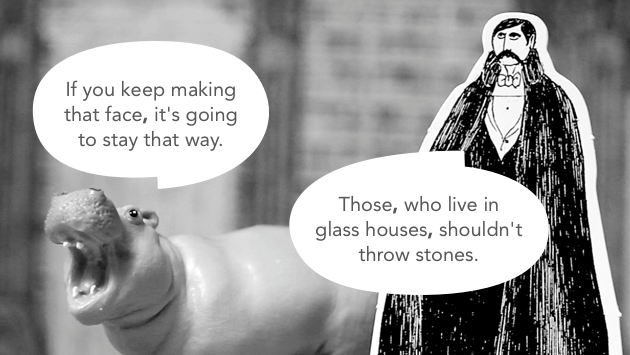
Not quite!
Here, an essential clause has been mistaken for a nonessential clause . The sentence should be written without commas instead:
Those who live in glass houses shouldn't throw stones.
Correct!
The comma in this sentence is used correctly. It separates the introductory clause ( if you keep making that face ) from the rest of the sentence ( it's going to stay that way ).
Common comma mistakes
Joining two sentences without a conjunction
People often make the error of using a comma to bring together two sentences without a conjunction. For example:
![She was a small-town girl, he was a city boy. [WRONG] / She was a small-town girl, and he was a city boy. [RIGHT]](https://media.gcflearnfree.org/ctassets/modules/49/small-town_girl.png)
Notice how the starting time version of the sentence is missing something? It needs a conjunction like and or simply to join the 2 halves properly. You lot could also apply a semi-colon to correct it instead: She was a small-town-girl; he was a city boy . Or y'all could rewrite the sentence as two sentences, with a period in betwixt.
Joining a chemical compound subject or predicate
Retrieve how you're supposed to employ a comma to carve up 3 or more items in a list? Exist conscientious non to get overboard and start separating two items that belong together (in other words, a chemical compound subject or predicate).
![Aunt Ruth used to date the gym teacher, and the principal. [WRONG] / Aunt Ruth used to date the gym teacher and the principal. [RIGHT]](https://media.gcflearnfree.org/ctassets/modules/49/aunt_ruth.png)
It might help to retrieve of the chemical compound equally a unmarried thought or thought. In the case above, the gym teacher and the principal are both office of Aunt Ruth's dating history—and they're the only things listed. You wouldn't suspension them up unless and the master was rewritten as a complete sentence. For case: Aunt Ruth used to date the gym teacher, simply she dumped him for the principal .
When a fragment follows a judgement
It'south easy to confuse a fragment at the end of a sentence with an introductory clause—they do expect similar. We already touched on this rule when we went over introductory clauses, but it can't injure to review it again.
![I went to Vegas, while my husband went camping. [WRONG] / I went to Vegas while my husband went camping. [RIGHT]](https://media.gcflearnfree.org/ctassets/modules/49/vegas_camping.png)
A fragment just works as an introductory clause if it'due south at the get-go of a sentence. If it'due south at the end, you don't demand a comma. In this example, the sentence would need a comma only if information technology was written in the contrary society: While my husband went camping ground, I went to Vegas .
Forcing a pause
Using a comma to force the reader to pause is a common mistake. Just recall: Commas are meant to brand things easier to read, non necessarily influence the mode they're read.
![And that, is how you deep-fry a turkey. [WRONG] / And that... is how you deep-fry a turkey. [RIGHT]](https://media.gcflearnfree.org/ctassets/modules/49/deep-fry_turkey.png)
If you want the reader to pause, you lot'll have to get creative with your formatting. For instance, you could use an ellipses (a very mutual way of indicating a pause), like in the example in a higher place. Or you could write the discussion you want to emphasize in all caps or italics. This way, the reader can really feel the weight of it: And THAT is how you deep-fry a turkey .
/en/grammer/homophones/content/
Source: https://edu.gcfglobal.org/en/grammar/commas/1/
0 Response to "She Again Went Comma After Again"
Post a Comment